
Peckham is a district in south-east London, within the London Borough of Southwark. It is 3.5 miles (5.6 km) south-east of Charing Cross. At the 2001 Census the Peckham ward had a population of 14,720.
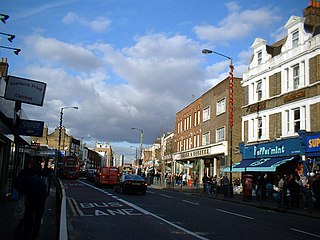
Walworth is a district of south London, England, within the London Borough of Southwark. It adjoins Camberwell to the south and Elephant and Castle to the north, and is 1.9 miles (3.1 km) south-east of Charing Cross.

Elephant and Castle is an area of South London, England, in the London Borough of Southwark. The name also informally refers to much of Walworth and Newington, due to the proximity of the London Underground station of the same name. The name is derived from a local coaching inn.

New Kent Road is a 1 kilometre (0.6 mi) road in the London Borough of Southwark. The road was created in 1751 when the Turnpike Trust upgraded a local footpath. This was done as part of the general road improvements associated with the creation of Westminster Bridge; in effect it was possible to travel from the West End/ Westminster to the south-east without having to go via the Borough of Southwark but could now cross St George's Fields to the junction of Newington Causeway and Newington Butts which is where New Kent Road starts at Elephant & Castle. The route runs eastward for a few hundred yards to the junction of Great Dover Street and Tower Bridge Road, known as Bricklayers Arms, where it joins the original route to the south-east Old Kent Road.

An apartment, flat, or unit is a self-contained housing unit that occupies part of a building, generally on a single storey. There are many names for these overall buildings. The housing tenure of apartments also varies considerably, from large-scale public housing, to owner occupancy within what is legally a condominium, to tenants renting from a private landlord.

Infoshops are places in which people can access anarchist or autonomist ideas. They are often stand-alone projects, or can form part of a larger radical bookshop, archive, self-managed social centre or community centre. Typically, infoshops offer flyers, posters, zines, pamphlets and books for sale or donation. Other items such as badges, locally produced artworks and T-shirts are also often available. Infoshops can also provide printing and copying facilities for people to produce their own literature or have a meeting space.

Stamford Street is a street in Lambeth and Southwark, London, England, just south of the River Thames. It runs between Waterloo Road to the west and Blackfriars Road to the east. It forms part of the A3200.

Self-managed social centres in the United Kingdom can be found in squatted, rented, mortgaged and fully owned buildings. These self-managed social centres differ from community centres in that they are self-organised under anti-authoritarian principles and volunteer-run, without any assistance from the state. The largest number have occurred in London from the 1980s onwards, although projects exist in most cities across the UK, linked in a network. Squatted social centres tend to be quickly evicted and therefore some projects deliberately choose a short-term existence, such as A-Spire in Leeds or the Okasional Café in Manchester. Longer term social centres include the 1 in 12 Club in Bradford, the Cowley Club in Brighton and the Sumac Centre in Nottingham, which are co-operatively owned.
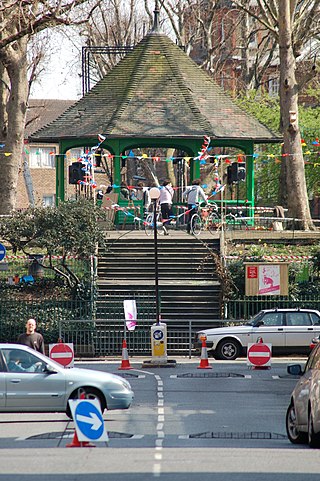
The Boundary Estate is a housing development in the London Borough of Tower Hamlets, in the East End of London.

Perronet House is an 11-storey residential council tower block adjacent to the northern roundabout of the Elephant and Castle, in London.
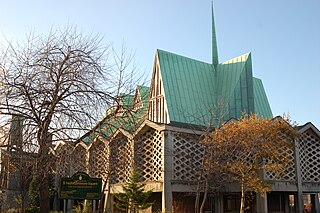
Lorrimore Square is a 1.5-acre (0.6 ha) garden square in the far south-west of Southwark, London, England, centred 500 metres south-east of Kennington tube station. It is divided into four sections, a church with integrated drop-in centre; a small enclosed garden without paths; a public playground/gardens; and a basketball/netball pitch. One side of the square is classical architecture of four storeys, the other two sides — the fourth side marks the end of units on another road — are late 20th century rows of apartments of slightly lower height.

Whitechapel High Street is a street in the Borough of Tower Hamlets in the East End of London. It is about 0.2 miles long, making it "one of the shortest high streets in London". It links Aldgate High Street to the south-west with Whitechapel Road to the north-east, and includes junctions with Commercial Street to the north and Commercial Road to the east.

Strata SE1 is a 147-metre (482 ft), 43-storey, multi-award-winning, building at Elephant & Castle in the London Borough of Southwark with more than 1,000 residents living in its 408 flats.

The Ossulston Estate is a multi-storey council estate built by the London County Council on Chalton Street in Somers Town between 1927 and 1931. It was unusual at the time both in its inner-city location and in its modernist design, and all the original parts of the estate are now Grade II listed buildings.
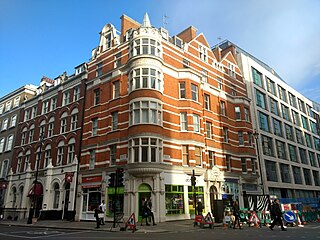
Berners Mansions is a six-storey Edwardian mansion block located in Berners Street in the City of Westminster. Berners Mansions was designed in 1897 by George Dennis Martin (1848-1915), Architect, of Pall Mall East. It is an unlisted building of merit within the Charlotte Street West Conservation Area and recognised as a positive contributor to the townscape of Berners Street and East Marylebone. It is a red brick building situated on the corner of Berners Street and Mortimer Street, opposite the site of the former Middlesex Hospital and comprises 10 residential flats and 4 ground floor shops.

Minerva House was built between 1979 and 1983 as the London office of Grindlays Bank with Twigg, Brown & Partners as architects. The yellow brick building features narrow windows between closely paired piers. It sits on the south bank of the River Thames just west of London Bridge.
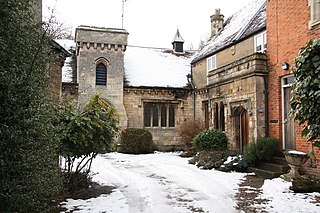
The Manor House is a set of connected buildings located on Northgate in the English town of Sleaford, Lincolnshire. A complex arrangement, parts of the Manor House date to the 16th century, but they were extended with the addition of the Georgian Rhodes House and later Gothic-Revival work. It was a private residence until the 20th century, and is now divided into commercial properties and residential apartments. The house was owned by a number of families and individuals, including local banker and businessman Benjamin Handley and Sophia Peacock, whose nephews, Cecil and Frank Rhodes, spent their summers at the estate as children.

Highpoint is a 142-metre, 46-storey, 458-apartment residential tower in Elephant and Castle in the London Borough of Southwark in London on the site of the London Park Hotel.

Old Woolwich or Woolwich Central Riverside is an area along the Thames in Woolwich, South East London. It is the oldest inhabited part of Woolwich, going back to an Anglo-Saxon riverside settlement. When the demographic centre of Woolwich shifted south in the 1800s, the area became a Victorian slum. Most of Old Woolwich was cleared in the 20th and early 21st centuries to make way for industrial, infrastructural and other large-scale developments. Although most of the earlier buildings have been demolished, the area has retained some interesting architecture, including the Georgian parish church, the Edwardian foot tunnel rotunda and two cinemas of the 1930s.

Cronulla Post Office is a heritage-listed post office at 41 Cronulla Street, Cronulla, Sydney, New South Wales, Australia. It was designed by Edwin Hubert Henderson of the Commonwealth Department of Works and Railways and built in 1924. It was added to the Australian Commonwealth Heritage List on 22 August 2012.





















